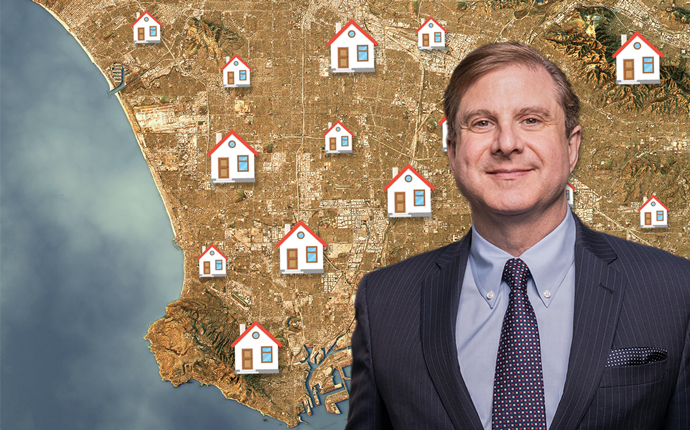Trending
Controller Ron Galperin on the untapped potential of LA’s massive property portfolio
"Now mind you, our interests as a city are not exactly those of a private developer"

Before Ron Galperin tallied all 14,000 publicly-owned properties within the city limits this summer, there had been no previous accounting.
That shocked Galperin, who as Los Angeles Controller is tasked with conducting financial and management audits of the sprawling metropolis, recommending policy changes and overseeing payroll for the city’s more than 61,000 employees.
In June, Galperin released an interactive map called “Property Panel” that details each one, and proposed creating a nonprofit — the Los Angeles Municipal Development Corp. — that would oversee the massive real estate portfolio. The city itself owns around 7,500 of those properties, with the rest controlled by county, state, and various other governmental bodies.
The Real Deal caught up with Galperin at his Downtown office, where he sketched out possible development opportunities and what the city’s role might be. He noted that some of the properties may be more suitable to higher-priced housing than affordable construction, and proceeds could be used to fund affordable housing elsewhere.
His office also released an audit this month that found the $1.2 billion affordable housing bond program — known as Proposition HHH — is wildly expensive, and would likely not be able to meet the city’s goal of building 7,000 permanent homes. Labor costs, slow permitting and litigation have led to spiking development bills.
Galperin said that the nonprofit he wants to oversee the portfolio could still be 18 months away— provided it gets the backing of City Council. He also retained Beacon Economics, an L.A.-based independent research firm, that will identify “clusters” of potential areas targeted for commercial and residential development.
The interview has been edited for length and clarity.
What are your thoughts on current commercial real estate opportunities in L.A.?
It’s always been a huge interest of mine, especially real estate within the context of government. How do we really capitalize [on] this amazing asset that we have, to the best public benefit?
Where are you at with identification of parcels in the city?
I was stunned that the city didn’t even know what it owns. And you look at how this city came to be what it is, and how so many cities come to be what they are. The real estate business has always been a keystone, a key economic driver for Los Angeles.
Why have those properties not been developed?
The government doesn’t always think entrepreneurial. Government, when it comes to real estate, thinks in terms of RFPs — request for proposals — RFQs — request for qualifications — and not in terms of deals.
What we have to do is find a way to really bring in some of the outstanding private sector expertise to help, which is why I recommended the creation of the Los Angeles Municipal Development Corporation. Now mind you, our interests as a city are not exactly those of a private developer – it’s not just about the highest and best use. It’s not just about monetary profit, although I think we should look at that as well.
What are some possibilities?
If we own properties in particularly valuable areas, it’s not about necessarily creating affordable housing. We might even allow it to be used for more expensive housing and generate revenue that can be used for affordable housing.
New York City netted more than $500 million from 46 land transactions. Can L.A. do better?
Well, look, I will be happy to just see a modest start and let this LAMDC kind of get its legs. Sometimes you need to walk before you can run. There are examples all over the country — and all over the world — and I think aside from human capital, the real estate owned by the city is arguably the largest single asset that this city has. I’m not suggesting that we develop it all, or sell it unnecessarily. But we need to look at how to realize value for the public good.
You must have a sense of the value of that property, right?
It’s very hard to come up with value, since value is based on how a property is zoned. Let’s say you have a park in a particular location. Even if the LAMDC was up and running, value is based on what you allow to be built in a particular location.
Would the LAMDC market properties for sale?
I don’t see it marketing properties at this point. We retained an economics firm to evaluate some of the properties — Beacon Economics. I don’t want to say too much about it until we get a report back from them.
Is Beacon looking at the value of L.A.’s properties listed in the Property Panel?
They are looking at clusters, or areas that are predicted for certain kinds of development. I would refer to those as underutilized properties. In the past the city always talked about surplus, but surplus basically meant that no department had any use for it whatsoever. I don’t think of these in terms of surplus but in terms of underutilized. They have a current use, but it’s just not as useful as it might otherwise be.
How much underutilized property has been identified in your Property Panel database?
I think we have a tremendous amount of it. I am fine just identifying a select number of properties in each Council district that this entity that would look at. Opportunities that could become a joint venture, a public-private partnership, or just part of the city’s development plans.
Where is the concentration of available commercial real estate for development in the city?
There’s plenty of high-priced development that is happening in Downtown. But I’m talking about vast swaths of the city where there has been very little that has been built compared to the population in those communities. They can be in parts of South Los Angeles, in parts of the Alameda Corridor [a transportation corridor of train lines that extend from L.A.’s port complex to downtown L.A.], and communities in the San Fernando Valley. It’s not limited to one geographic area.




